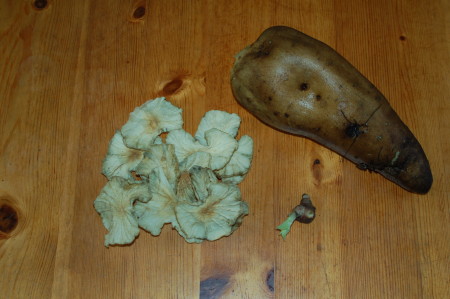
I’ve posted a couple of times about the yacon plants I grew this year with stem tubers from my friend Frank in Belgium. Of all of my Lost Crops of the Incas, this may have turned out to be the most interesting.
In the picture above you see the large tuber on the right, weighing in at about a kilogram. The white things you see on the left are ‘yacón chips’, made by slicing the tuber thinly and drying the pieces in the dehydrator. The small thing on the bottom right is a small cluster of three stem tubers, one of which has started growing already.
This plant is incredibly productive. Supposedly it’s three times as productive as potatoes in the same space, and each plant yields about 10Kg of tubers! Partly as a result, the plants take up a lot of space in the garden. Each plant needs 90-100cm is all directions. The tops of the plants are quite large as well, and can shade other nearby plants. Growing the plants in a block, can help them provide support for one another, and in any case some extra support may be needed. In my garden they grew to about 1.5m in height.
The basic procedure is to start growing the stem tuber indoors in February, then plant out after the last frost date. When starting them indoors, keep in mind the plants will grow pretty quickly, so be sure to give them a large enough pot. The first frost in the fall will kill the tops of the plants, which are quite frost tender, and they will shrivel soon afterwards. You can then cut the stem at about 20cm from the ground and carefully dig up the roots. The roots are very easily damaged, so be careful when digging them. If you don’t get a frost before the winter solstice, you should probably dig the plants around then anyway.
After digging up the plant, place it in a wooden or plastic container with some holes at the bottom to let water drain. It’s probably best not to disturb the tubers by washing them. Place the plants in a root cellar or unheated room, protected from frost. Leave uncovered and don’t eat for at least the first month, because in this time the tubers will become sweeter. After the first month, you can cover the tubers with sand or peat if you want, but I didn’t find this necessary. In any case you do need to keep them from drying out too much, and I did this by covering them loosely with a damp towel. Simply eat tubers over the course of the winter as desired, and in February harvest the stem tubers for next years plants.
Eating
The taste is nice, but not really outstanding. In fact the biggest problem I had was Steph doesn’t care for it at all, so I was stuck eating both of the plants I grew on my own, and that was just too much for me. I’ve still only eaten about half of what I grew, but it’s still storing well. I’ve even given some of it away already.
It’s a bit of a problem that most of the tubers seem to weigh more than a kilo, too much for just me to eat, and they don’t store well after being cut open.
The skin is a little bitter, so I think most people will prefer to peel it. It is nice raw, crispy juicy with the taste of a melon but not so intense. It is very high in sugar, but not ordinary sugars.
It can also be sauteed in butter, until the sugar carmelizes a bit. This is probably my favorite way to eat it.
I understand it can also be added to stirfrys, but I haven’t tried this. I don’t like sweet things in my stirfrys, and since Steph won’t eat it I would have to make a one person stirfry, which I don’t do often anyway.
You can make yacón chips, like in the picture above by putting it in a dehydrator. I didn’t pretreat the yacón before drying it, just sliced it thinly. The taste of the chips is similar to dried fruit, perhaps well suited as an exotic party snack. The taste becomes more intense after drying. Time will tell if I still like eating the chips in a few months…
Beyond this you can make yacón wine, and there are some companies selling yacón syrup. I understand in theory at least, it has the potential to be a good plant to make biofuel from, because the sugars can easily be converted to alcohol.
Because the sugar is not ‘real’ sugar, it tends to leave you a little unsatisfied after eating it. I understand the special sugars can also give you wind if you eat too much, but I don’t seem to have that problem. Eating too much can give you a real empty/full feeling.
Tubers Available!
Okay, so if after reading this you are convinced you want to try growing it, you’re in luck because I have some stem tubers available.
I’m a little concerned about making an offer like this, because among other things there’s been lots of interest expressed over the Internet and a lot of people are looking for tubers. Real Seeds in the UK just reported they had a crop failure this year, so I seem to be the only source in Europe at the moment! I don’t have enough to send out hundreds and hundreds of stem tubers, and I’m probably going to disappoint a lot of you who ask for some. I probably only have 30 or 40 in total, and I’ll probably send most people who ask 2 of them.
At this point I don’t know for sure how many I have, and I don’t think I’ll know for sure until I start cutting the stem tubers off in a couple of weeks. I would like to start collecting a list of people who are interested, so if you want some please send me an email now. In the email please be sure to give me your address. One way or another I will get back to you and let you know.
I’ve already promised a number of people I would send them tubers, and they have first priority. After this, I will give priority to people who are closest to me geographically and/or express an intent to reoffer tubers next year via the Blogger Seed Network. After this, I’ll give people who participate in this blog with comments or links from their own blogs. After that it will be first come first served.
If I’ve already talked to you and said I would send you some tubers, I will send you an email in the next day or two. If you don’t get an email, please get in touch. My memory for this kind of thing is not very good!


